Research News
-
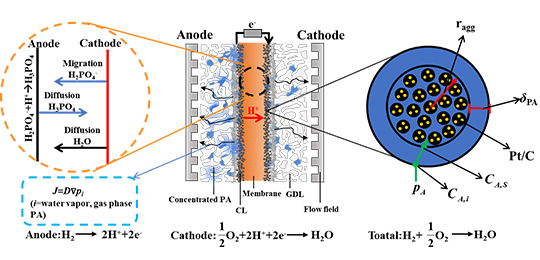 04 25, 2022Predicting Distribution of Phosphoric Acid and Water in High-temperature Polymer Electrolyte Membrane Fuel CellScientists developed a novel multicomponent multiphase model to predict the distribution of phosphoric acid and water in HT-PEMFC.
04 25, 2022Predicting Distribution of Phosphoric Acid and Water in High-temperature Polymer Electrolyte Membrane Fuel CellScientists developed a novel multicomponent multiphase model to predict the distribution of phosphoric acid and water in HT-PEMFC.
High-temperature polymer electrolyte membrane fuel cell (HT-PEMFC) can be applied in electric vehicles and marine power supplies.
However, the electrolyte in the HT-PEMFC is concentrated phosphoric acid, which electro-migrates from the cathode to the anode during fuel cell operation, leading to phosphoric acid redistribution and thereby affecting the multiphase mass transfer and electrochemical reaction inside the fuel cell.
Recently, a research group led by Prof. SUN Gongquan and Prof. WANG Suli from the Dalian Institute of Chemical Physics (DICP) of the Chinese Academy of Sciences (CAS) developed a novel multicomponent multiphase model to predict the distribution of phosphoric acid and water in HT-PEMFC, which can help to better understand the effects of materials, structures, and operating conditions on the multiphase transport of water and phosphoric acid.
This study was published in AIChE Journal on April 9.
Schematic of the cathode catalyst layer based on the agglomerate assumption (Image by SUN Mu)
The researchers explored the transport mechanism of water and phosphoric acid inside the HT-PEMFC and its impact on fuel cell performance by constructing a three-dimensional, non-isothermal, multiphase HT-PEMFC model based on a catalytic layer spherical agglomerate sub-model.
This model could predict the performance of the fuel cell. It included multicomponent multiphase transport of phosphoric acid and water model, and the energy transport model.
The simulation results showed that the phosphoric acid concentration in the anode was higher than that in the cathode, and about 20% of the water generated from the cathode diffuses to the anode in the form of the liquid phase.
"This study provides a theoretical basis for the optimization of the design of materials, structure, and operating conditions," said Prof. SUN.
The above work was supported by DICP, the National Natural Science Foundation of China, and CAS. (Text by SUN Mu) -
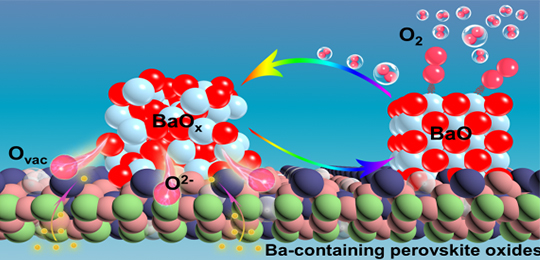 04 22, 2022Researchers Reveal Mechanism of Oxygen Activation on Barium-containing Perovskite Materials
04 22, 2022Researchers Reveal Mechanism of Oxygen Activation on Barium-containing Perovskite Materials
A research team led by Prof. YANG Weishen and Prof. ZHU Xuefeng from the Dalian Institute of Chemical Physics (DICP) of the Chinese Academy of Sciences (CAS) has revealed the mechanism of oxygen activation on Barium-containing perovskite materials.
The researchers discovered that BaO/BaO2 nanoparticles precipitated on the surface of Ba-containing materials under high-temperature oxygen-rich conditions had an ultra-high activity for oxygen activation, which clarified the mechanism of high-temperature oxygen activation and transport on the surface of Ba-containing perovskite oxides.
This study was published on Science Advances on April 13.
Oxygen activation mechanism on Ba-containing perovskite oxides (Image by ZHU Yue)
In 2000, the DICP team invented an oxygen-permeable membrane material named Ba0.5Sr0.5Co0.8Fe0.2O3-δ (BSCF). Due to its good catalytic activity towards oxygen activation, BSCF has become a representative material for oxygen permeation and has been widely used in solid oxide fuel cells, oxygen reduction reactions, and oxygen evolution reactions.
However, the essence of the good performance of the BSCF perovskite is still unclear.
In this study, the researchers analyzed the oxygen permeation process and found that the addition of Ba into perovskite oxides could accelerate the oxygen surface exchange reaction kinetics.
They identified the precipitation of BaOx nanoparticles on the surface of BSCF materials in a high-temperature oxygen atmosphere by environmental electron microscopy, and proved that Ba-containing materials could be precipitated or decomposed into BaOx have high catalytic activity for the oxygen activation process.
Moreover, combined with DFT calculation, they found that the precipitated BaOx nanoparticles could reduce the energy barriers of oxygen molecule adsorption and dissociation in the oxygen reduction process and oxygen desorption process, thus accelerating the oxygen exchange reaction kinetics at the gas-solid interface.
"This study provides a scientific basis for the design of oxygen-permeable membranes and electrocatalytic materials," said Prof. YANG.
The above work was supported by the Pilot Project of CAS, the National Natural Science Foundation of China, and the China Postdoctoral Foundation. (Text by ZHU Yue) -
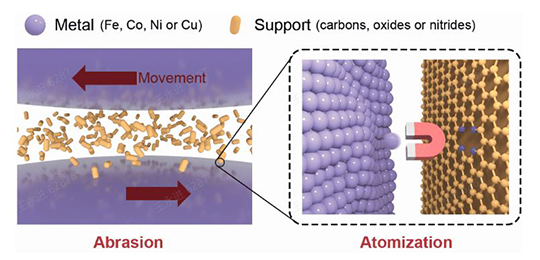 04 22, 2022Mössbauer Spectroscopic Technique Enables Precise Characterization of Single Atom Iron CatalystScientists realized the precise characterization of mechanochemically prepared single atom iron catalyst by using Mossbauer spectroscopy technique.
04 22, 2022Mössbauer Spectroscopic Technique Enables Precise Characterization of Single Atom Iron CatalystScientists realized the precise characterization of mechanochemically prepared single atom iron catalyst by using Mossbauer spectroscopy technique.
Recently, Prof. WANG Junhu's group from the Dalian Institute of Chemical Physics (DICP) of CAS, in collaboration with Prof. Jong-Beom Baek's group from Ulsan National Institute of Science and Technology (UNIST), realized the precise characterization of mechanochemically prepared single atom iron catalyst by using Mössbauer spectroscopy technique.
This work was published in Nature Nanotechnology on Feb. 7.
In the mechanochemical method, the bulk metal is applied as precursor rather than metal salts. No solvent is adopted, and there was even no water, no any byproducts nor wastes.
However, in the prepared single atom catalyst, there still exists occasionally formed metal clusters. Since these clusters are very less and only short-range ordered, even the high resolution extended X-ray absorption fine structure spectroscopy (EXAFS) is hard to quantitatively and qualitatively identify them.
In this study, the researchers resorted to 57Fe Mössbauer spectroscopy to reveal the coordination environment of Fe (mainly composed of Fe4N species), and detected a small amount of Fe clusters identified as Fe3C (S1), which were difficult to be found in other characterizations.
After heat-treatment purification, even the content of Fe3C was only 4%, it could also be easily detected by Mössbauer spectroscopy.
"Our studies demonstrated that Mössbauer spectroscopy is one of the most important techniques to characterize the purity of single atom Fe," said Prof. WANG.
Characterizations of Fe–N–C single atom catalysts (Image by HAN Gaofeng)
This work was supported by the National Key Research and Development Program of China, the National Natural Science Foundation of China, and the International Partnership Program of CAS. (Text by HAN Gaofeng) -
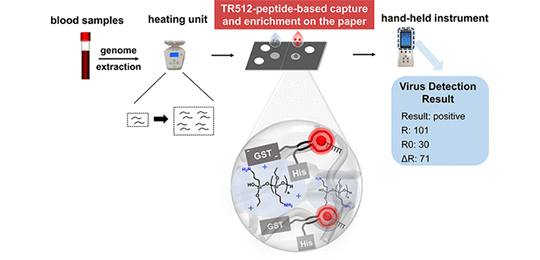 04 22, 2022Novel Virus Detection Strategy Enabled by Colorimetric Sensor of Functionalized PaperScientists proposed a novel virus detection strategy enabled by TR512-peptide-based bioorthogonal capture of the functionalized paper. With a home-developed full-set virus detection device, this platform achieved a rapid screen of viral infection.
04 22, 2022Novel Virus Detection Strategy Enabled by Colorimetric Sensor of Functionalized PaperScientists proposed a novel virus detection strategy enabled by TR512-peptide-based bioorthogonal capture of the functionalized paper. With a home-developed full-set virus detection device, this platform achieved a rapid screen of viral infection.
High-cost viral nucleic acid detection devices are limited resources for developing counties and rural areas, leading to underdiagnosis or even pandemics of viral infectious diseases.
Paper-based detection which can provide a point-of-care testing platform for convenient and inexpensive sensors has gained attention in the detecting of many small molecule analytes.
Recently, a research group led by Prof. FENG Liang collaborated with Prof. LIU Yu's group from the Dalian Institute of Chemical Physics (DICP) of the Chinese Academy of Science proposed a novel virus detection strategy enabled by TR512-peptide-based bioorthogonal capture of the functionalized paper. With a home-developed full-set virus detection device, this platform achieved a rapid screen of viral infection.
This study was published in Analytical Chemistry on March 29.
This novel detection method was enabled by TR512-peptide based biorthogonal capture and enrichment of commercially available Texas red fluorophore labeled nucleic acid on the functionalized paper. It was generally applicable to different nucleic acid preamplification strategies (PCR, RAA, CRISPR) and different virus types (HBV, ASFV, HPV16, HPV 18 etc.).
Moreover, they developed a full-set virus detection device in house to detect the presence of the Hepatitis B virus (HBV) viral gene in patients’ blood samples.
Furthermore, they applied TR512-peptide in the signal enrichment, thus the novel detection strategy could offer an inexpensive, rapid and portable solution for areas with limited access to standard diagnosis laboratories.
The study was supported by the CAS Scientific Instruments and Equipment Development Program. (Text by ZHU Mingzhen) -
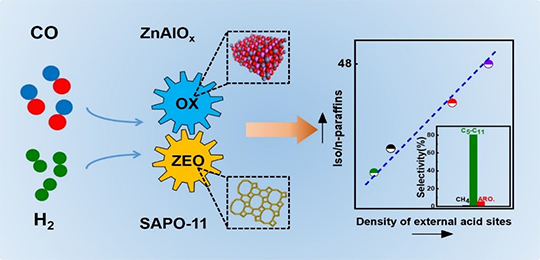 04 14, 2022Researchers Realize Direct Synthesis of Isoparaffin-rich Gasoline from SyngasScientists realized the direct synthesis of isoparaffin-rich gasoline from syngas using ZnAlOx-SAPO-11 OXZEO catalysts. They elucidated the active sites of isoparaffin formation, which provided important guidance for the one-step synthesis of high-quality gasoline from syngasA research team led by Prof. PAN Xiulian and Prof. BAO Xinhe from the Dalian Institute of Chemical Physics (DICP) of the Chinese Academy of Sciences (CAS) realized the direct synthesis of isoparaffin-rich gasoline from syngas using ZnAlOx-SAPO-11 oxide-zeolite (OXZEO) catalysts.They elucidated the active sites of isoparaffin formation, which provided guidance for the one-step synthesis of high-quality gasoline from syngas.This study was published in ACS Energy Letters on March 23.Previously, the DICP team proposed a new catalyst concept based on metal OXZEO bi-functional catalysts, and it enabled the direct conversion of syngas to a variety of chemicals and fuels with high selectivity, such as light olefins, ethylene, gasoline, aromatics and oxygenates. The OXZEO concept provided a new technology platform for the highly efficient utilization of coal and other carbon resources.Direct syngas conversion to isoparaffin-rich gasoline over OXZEO catalyst (Image by FENG Jingyao)In this study, they achieved 34% CO conversion and 82% gasoline selectivity by modulating the acid sites distribution of zeolite, in which the iso/n-paraffins ratio was as high as 38. By optimizing the reaction conditions, they increased the ratio of iso/n-paraffins as high as 48, which was the highest value of the iso/n-paraffins ratio reported so far.Moreover, a 150-hour on stream test of the catalyst indicated rather stable activity in syngas-to-gasoline.Further studies showed that the external acid sites of the zeolite could be the active sites for the formation of branched, especially the multi-branched isoparaffins."This study provided important guidance for the one-step synthesis of high-quality gasoline from syngas and even CO2," said Prof. PAN.The above work was supported by the Ministry of Science and Technology of China, the National Natural Science Foundation of China, the Dalian High-level Talent Innovation Program, and the Youth Innovation Promotion Association of CAS. (Text by FENG Jingyao)
04 14, 2022Researchers Realize Direct Synthesis of Isoparaffin-rich Gasoline from SyngasScientists realized the direct synthesis of isoparaffin-rich gasoline from syngas using ZnAlOx-SAPO-11 OXZEO catalysts. They elucidated the active sites of isoparaffin formation, which provided important guidance for the one-step synthesis of high-quality gasoline from syngasA research team led by Prof. PAN Xiulian and Prof. BAO Xinhe from the Dalian Institute of Chemical Physics (DICP) of the Chinese Academy of Sciences (CAS) realized the direct synthesis of isoparaffin-rich gasoline from syngas using ZnAlOx-SAPO-11 oxide-zeolite (OXZEO) catalysts.They elucidated the active sites of isoparaffin formation, which provided guidance for the one-step synthesis of high-quality gasoline from syngas.This study was published in ACS Energy Letters on March 23.Previously, the DICP team proposed a new catalyst concept based on metal OXZEO bi-functional catalysts, and it enabled the direct conversion of syngas to a variety of chemicals and fuels with high selectivity, such as light olefins, ethylene, gasoline, aromatics and oxygenates. The OXZEO concept provided a new technology platform for the highly efficient utilization of coal and other carbon resources.Direct syngas conversion to isoparaffin-rich gasoline over OXZEO catalyst (Image by FENG Jingyao)In this study, they achieved 34% CO conversion and 82% gasoline selectivity by modulating the acid sites distribution of zeolite, in which the iso/n-paraffins ratio was as high as 38. By optimizing the reaction conditions, they increased the ratio of iso/n-paraffins as high as 48, which was the highest value of the iso/n-paraffins ratio reported so far.Moreover, a 150-hour on stream test of the catalyst indicated rather stable activity in syngas-to-gasoline.Further studies showed that the external acid sites of the zeolite could be the active sites for the formation of branched, especially the multi-branched isoparaffins."This study provided important guidance for the one-step synthesis of high-quality gasoline from syngas and even CO2," said Prof. PAN.The above work was supported by the Ministry of Science and Technology of China, the National Natural Science Foundation of China, the Dalian High-level Talent Innovation Program, and the Youth Innovation Promotion Association of CAS. (Text by FENG Jingyao) -
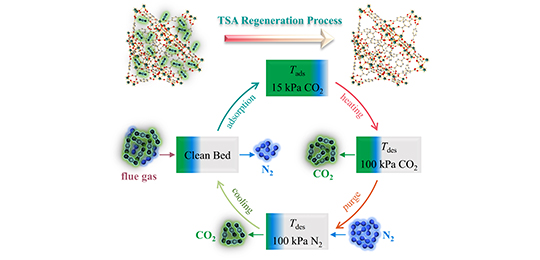 04 14, 2022New Experimental Strategy to Evaluate Energy Performance of Metal-organic Framework-based Carbon Dioxide Adsorbents
04 14, 2022New Experimental Strategy to Evaluate Energy Performance of Metal-organic Framework-based Carbon Dioxide Adsorbents
As promising carbon dioxide (CO2) adsorbents, metal-organic frameworks (MOFs) have attracted much attention in the field of carbon capture and storage (CCS).
In addition to the adsorption property, the energy performance related to the regeneration process is also a crucial factor when screening for suitable MOF adsorbents.
Recently, a research team led by Prof. SHI Quan from the Dalian Institute of Chemical Physics (DICP) of the Chinese Academy of Sciences (CAS), in collaboration with Prof. HAN Wei from the Hong Kong University of Science and Technology, proposed an experimental strategy to investigate the energy performance of MOF adsorbents for CO2 capture in the temperature swing adsorption (TSA) process.
This study was published in Chemical Engineering Journal on April 10.
Schematic diagram of CO2 adsorbents loop in a post-combustion TSA cycle (Image by LUO Jipeng)
The strategy is based on the combination of calorimetry and thermal analysis method. The researchers evaluated five well-characterized isomorphic zirconium-based MOFs using this strategy.
They analyzed the CO2 adsorption and desorption process using a thermogravimetric analysis instrument with a temperature-step program, and determined the desorption temperatures for these MOFs. The CO2 uptake and desorption heats of these MOFs were obtained from general isothermal adsorption measurements.
More importantly, the specific heat capacities of these MOFs were measured using a relaxation calorimeter, and their sensible heat values in the temperature swing range were calculated accordingly.
"The energy properties involved in the TSA process, including the regeneration energy, CO2 working capacity, and the corresponding parasitic energy, were efficiently and reliably evaluated," said Prof. SHI.
The results indicated that the sensible heat for heating the adsorbents from adsorption temperature to desorption temperature dominated the regeneration energy, and the parasitic energy was inversely proportional to the working capacity.
The proposed strategy contains few assumptions, and has sufficient resolution to distinguish small differences in energy efficiency-related properties of MOFs with similar structures and/or compositions.
"This new strategy may provide a feasible and effective experimental approach to study and evaluate the potential of adsorbents for CO2 capture," said Prof. SHI.
"This work can be a good reference for MOF adsorbent testing metrology development," commented one of the reviewers.
This work was supported by the Joint Fund of the Yulin University and Dalian National Laboratory for Clean Energy, the National Nature Science Foundation of China, and the DNL Cooperation Fund, CAS. (Text by LUO Jipeng and ZHANG Jian)